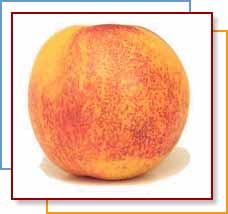Home | FOOD ARTICLES | Food Trivia | Today_in_Food_History | Food_History_Timeline | Recipes | Cooking_Tips | Food_Videos | Food_Quotes | Who’s_Who | Culinary_Schools_&_Tours | Food_Trivia_Quizzes | Food_Poems | Free_Magazines | Food_Festivals_and_Events
Food Articles, News & Features Section
FREE Magazines
and other Publications
Free Professional and Technical Research, White Papers, Case Studies, Magazines, and eBooks
NECTARINES
See also: Article 2 Nectarines - Nectarine Quotes - Nectarine Trivia
Fruit of the Month
Commonly showcased side by side with peaches, nectarines are a similar, but yet different fruit. The best way to identify the difference between a nectarine and peach is by the lack of fuzz on the nectarine.
Nectarines, like peaches, most likely originated in China more than 2,000 years ago and were cultivated in ancient Persia, Greece and Rome. They were grown in Great Britain in the late 16th or early 17th centuries, and were introduced to America by the Spanish. Today, California grows over 95% of the nectarines produced in the United States.

Nectarines are smaller and smooth skinned golden yellow with large blushes of red. Their yellow flesh has a noticeable pink tinge, with a distinct aroma and a more pronounced flavor. There are more than 100 varieties of nectarine, in freestone and clingstone varieties. In freestone types the flesh separates from the 'pit' easily, while clingstone types cling to the 'pit.' Nectarines are more delicate than peaches and bruise very easily.
Nectarines are a good source of vitamin C and low in calories with no sodium or cholesterol.
Selection
Ripe fruit are fragrant and give, slightly, to the touch. If they are a under-ripe, leave them at room temperature for 2–3 days to ripen. Look for fruit with smooth unblemished skin. Avoid extremely hard or dull colored fruits and soft fruit with soft, wrinkled, punctured skin.
Storage
Nectarines keep for 5 days if stored in a plastic bag in the coldest part of your refrigerator.
Preparation
Nectarines can be used and prepared in the same ways as peaches, with no need to peel because they have no fuzz. Leave the skins on when making pies, cobblers and fresh fruit salads, etc.
Availability
California nectarines are available from late April and to late August. Almost all of the nectarines available are in California. Chiliean Nectarines are available from late December through early March.
- Make Nectarines Part of Your 5 A Day Plan
- Bake peeled, halved, pitted fruit, cut-side up in a baking pan sprinkled with honey and cinnamon and cooked until tender.
- Grilled nectarines are a wonderful tasty treat! Be sure to brush the fruit with fruit juices and cook until it is heated through.
- Poached nectarines in fruit juice or wine and cook until tender…a simple, elegant way to end a meal.
- Nectarines make a good substitute in any recipe that calls for peaches or apricots.
- Puree ripe nectarines with skim milk, non-fat yogurt, or orange juice for a tasty breakfast treat.
- Serve pancakes, waffles, or French toast with sliced or chopped nectarines.
- Add cut up nectarines to your favorite fruit salad.
- Serve baked nectarines with baked chicken or ham as delicious side dish.
RELATED ARTICLES
Please feel free to link to any pages of FoodReference.com from your website.
For permission to use any of this content please E-mail: james@foodreference.com
All contents are copyright © 1990 - 2026 James T. Ehler and www.FoodReference.com unless otherwise noted. All rights reserved.
You may copy and use portions of this website for non-commercial, personal use only.
Any other use of these materials without prior written authorization is not very nice and violates the copyright.
Please take the time to request permission.


